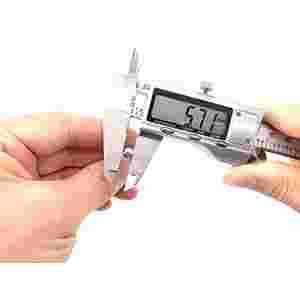Jul 18,2023

Accurate distance measurement is a crucial aspect of various fields, including construction, engineering, architecture, and land surveying. To achieve precise measurements, professionals rely on a range of tools specifically designed for this purpose. In this blog, we will explore the different types of tools used for measuring distance, from traditional to advanced options, as well as digital mapping tools. By understanding the features and applications of these tools, you can make informed decisions when it comes to selecting the right tool for your specific needs.
A tape measure is a ubiquitous tool used for measuring distances manually. It consists of flexible tape, usually made of metal or fiberglass, with markings indicating length. To measure distance, the tape is extended between two points, and the measurement is read off the tape. Tape measures are commonly used in various industries, especially for shorter distances. They are portable and relatively inexpensive, but their accuracy can be affected by factors such as tape sagging and human error.
Measuring wheels, also known as surveyor's wheels or clickwheels, are tools designed for measuring longer distances quickly. They consist of a wheel attached to a handle and a counter that tracks the number of rotations. As the wheel rolls along the ground, the counter measures the distance covered. Measuring wheels are widely used in construction, landscaping, and road surveying. They offer good accuracy and are efficient for measuring distances on flat surfaces.
Similar to measuring wheels, surveyor's wheels are more advanced tools used by land surveyors and civil engineers. They feature a larger wheel and offer higher precision for measuring longer distances, often on uneven terrain. Surveyor's wheels are equipped with additional features such as telescopic handles, brakes, and recording devices to track measurements accurately. They provide reliable results but can be bulkier and more expensive than measuring wheels.
Laser distance measurers (LDMs) are modern handheld devices that use laser technology to measure distances with exceptional accuracy. By emitting laser pulses and calculating the time it takes for the pulses to bounce back, LDMs determine the distance between the device and the target. They offer precise measurements and can be used for both indoor and outdoor applications. LDMs are portable, easy to use, and provide quick results, making them popular among professionals in various industries.
Ultrasonic distance measurers utilize sound waves to measure distances. These devices emit ultrasonic pulses and measure the time it takes for the sound waves to reflect back from the target object. By analyzing the time taken, they calculate the distance. Ultrasonic distance measurers are often used in construction, architecture, and interior design. They are relatively affordable, easy to use, and offer reasonable accuracy for shorter distances.
Total stations are advanced surveying instruments used in the field of land surveying and construction. They integrate a range of capabilities, including distance measurement, angle measurement, and data recording. Total stations combine electronic theodolites with electronic distance measurement (EDM) technology, enabling precise measurements of distances, angles, and coordinates. They are highly accurate and commonly used in large-scale construction projects, topographic surveys, and mapping.
GPS technology utilizes satellites to determine precise locations and measure distances. GPS receivers receive signals from multiple satellites and calculate the distances based on the time it takes for the signals to reach the receiver. GPS is widely used in outdoor activities, navigation, and mapping. It provides accurate distance measurements and allows for real-time tracking of positions.
GIS is a powerful digital mapping tool that combines geographic data with various layers of information. It enables professionals to measure distances accurately by overlaying maps, satellite imagery, and other data sources. GIS is widely used in urban planning, environmental management, and infrastructure development. It offers advanced distance measurement capabilities, along with data analysis and visualization features.
With the advancement of technology, numerous mobile apps are available for distance measurement. These apps utilize the built-in sensors of smartphones, such as accelerometers and gyroscopes, to estimate distances. They offer convenience and portability, allowing users to measure distances on the go. While the accuracy may vary depending on the app and smartphone's capabilities, they can be useful for quick measurements and everyday applications.
Accuracy: Advanced tools such as laser distance measurers and total stations offer higher accuracy compared to traditional tools like tape measures.
Ease of use: Traditional tools like tape measures and measuring wheels are generally straightforward to use, while advanced tools and digital mapping tools may require some training.
Cost: The price range varies across different tools, with traditional tools being more affordable compared to advanced instruments like total stations.
Applicability for different scenarios: The choice of tool depends on the specific requirements of the task at hand, whether it's measuring distances in a construction site, conducting a land survey, or mapping geographic features.
Task requirements: Assess the nature of the project, the distance range, and the level of accuracy needed.
Budget constraints: Evaluate the available budget and determine the cost-effectiveness of different tools.
Skill level and training: Consider the expertise and training required to operate and interpret measurements from various tools.
By carefully considering these factors, you can choose the most suitable tool for your specific application, ensuring accurate distance measurements and efficient project execution.
Accurate distance measurement is essential in various industries, and the availability of different tools makes it easier to achieve precision. Traditional tools like tape measures and measuring wheels offer practical solutions for everyday measurements, while advanced instruments such as laser distance measurers and total stations provide higher accuracy and efficiency. Additionally, digital mapping tools like GPS and GIS offer advanced capabilities for spatial analysis and distance measurement. By understanding the features, pros, and cons of these tools, you can make informed decisions and choose the right tool for your specific needs. So, whether you are a professional in the construction industry or an outdoor enthusiast, having the right tools for measuring distance is crucial for successful project execution.